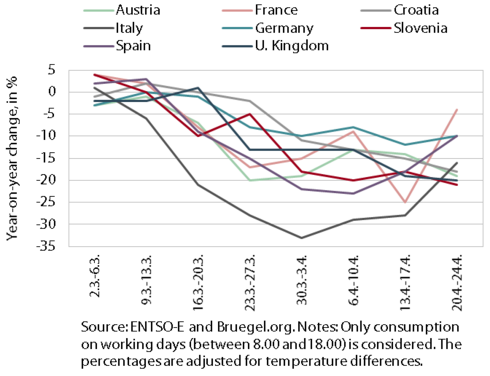Charts of the Week
Current economic trends from 28 to 30 April 2020: electricity consumption, traffic of electronically tolled vehicles on Slovenian motorways, consumer prices and yields to maturity of 10-year government bonds
After Easter, freight traffic on Slovenian motorways started to increase again, which is also a consequence of the relaxation of measures to stem the coronavirus in some countries. In the second half of April, however, it was still around a quarter lower than in the same period of last year. The year-on-year fall in electricity consumption in Slovenia has not yet started to decline. Due to the coronavirus epidemic, prices of oil products fell sharply, as did electricity prices due to the Slovenian Government measures. Both significantly contributed to the year-on-year decline in consumer prices in April. Owing to high uncertainty, yields to maturity of euro area bonds of peripheral EU countries increased in April (among them, more noticeably the yield of Slovenian bonds).
Electricity consumption, April 2020

The year-on-year fall in weekly electricity consumption in Slovenia has remained roughly unchanged since the beginning of April. Electricity consumption, which is one of the indicators of economic activity, was around 20% lower year on year in the fourth week of April. Slovenia has recorded a similar decline in consumption since the beginning of April. Despite the easing of some coronavirus containment measures in most other countries shown in the figure, a strengthening of consumption has yet to be seen. The decline in electricity consumption has also been gradually slowing in Italy and Spain and, in the last week, in France.
Traffic of electronically tolled vehicles on Slovenian motorways, April 2020

Freight traffic on Slovenian motorways, which has fallen markedly since the declaration of the epidemic, started to increase in the second half of April. It was around a quarter lower than in the same period of last year. The traffic volume of foreign trucks was a third lower and the traffic volume of domestic trucks around a fifth lower than one year earlier. At the beginning of the epidemic, the decline in foreign truck traffic (by more than 60%) significantly exceeded that in domestic truck traffic, but after Easter the difference started to narrow. This can be attributed to EU measures to ensure the free flow of goods across borders and to the relaxation of measures in some countries.
Consumer prices, April 2020

Consumer prices were lower year-on-year in April. The consequences of countries’ measures to stem the spread of the COVID-19 epidemic significantly contributed to a decline in prices of oil products, while the Slovenian Government measures also led to a fall in electricity prices. Together they contributed 2.2 percentage points to deflation. Without the adjustment of excise duties on oil products, the negative contribution would have been a further 0.1 of a percentage point higher. Durable goods prices remained lower year on year (–2%). This time prices of semi-durable goods also declined year on year (–2.8%). We estimate that this is to a great extent due to differences in data collection due to the closure of a large part of this type of stores and, partly, to lower demand for such goods. Food price growth continued to strengthen under the impact of increased demand and exceeded 5%. Growth in prices of services slowed further. However, for a certain part of prices that vary depending on the season (package holidays, accommodation services, flights), data collection was not possible due to the measures to contain the epidemic, so that monthly changes of April 2019 were taken into account.
Yields to maturity of 10-year government bonds, April 2020

Yields to maturity of euro area government bonds increased in April due to the COVID-19 epidemic. Because of the high level of uncertainty, part of demand shifted to safer investments, including bonds of core euro area countries. Thus, amid the increased borrowing needs of all countries, only yields to maturity of peripheral countries increased more noticeably. The rise in the yield to maturity of Slovenian bonds was among the most pronounced, as it more than doubled in April with regard to March, its spread to the German bond reaching 120 basis points.
